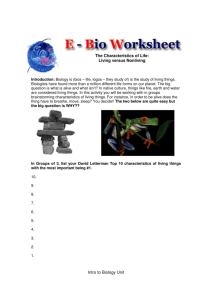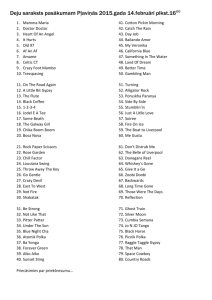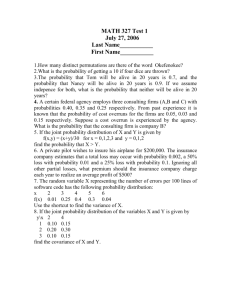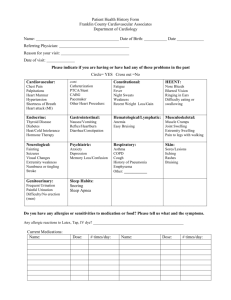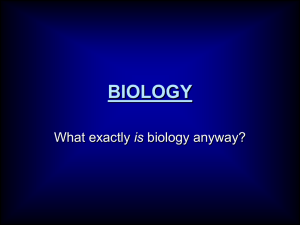Introduction to the Cell (PowerPoint) Madison 2009
advertisement
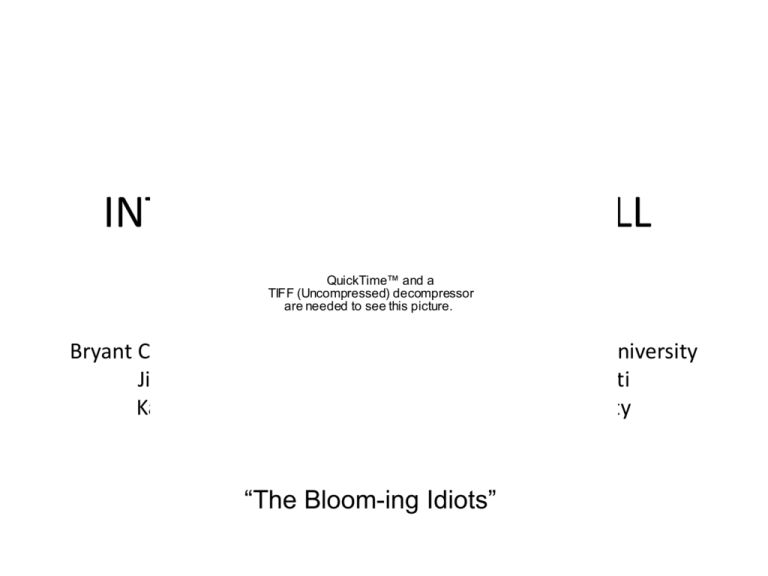
UNIT I: INTRODUCTION TO THE CELL QuickTime™ and a TIFF (Uncompressed) decompressor are needed to see this picture. Cell/Developmental Biology Group 4 Bryant Chase, Lloyd Epstein, Trisha Spears, Florida State University Jill Beyette and Brian Kinkle, University of Cincinnati Kathy Miller and Kathy Hafer, Washington University “The Bloom-ing Idiots” Context • First semester, introductory biology class for majors • Large lecture format (> 100 students) • The unit is designed to span 4-5 lectures • The tidbit is designed to be used the first day of lecture At the end of the unit, students should… Understand: 1. differences between living and non-living entities. Be able to: 1a. list defining properties of a living entity 1b. evaluate evidence and decide if an entity is alive or not alive 2. the essential 2a. draw and label parts of a cell; characteristics and defining 2b. describe the function of essential components of properties of a cell. the cell; 2c. explain leading hypotheses on the origin of cells; 2d. explain the origin of extant cells. 3. an organism can be one cell or many cells. 4. not all the cells are the same. 3. name 3 types of uni- and multicellular organisms. 5. scientific knowledge is incomplete and subject to change. 5. evaluate the ability of our current definition of life to accommodate new scientific and technological innovations 4a. list different types of cells (in a human). 4b. explain/suggest hypotheses for why some cells are different from others. 4c. compare & contrast prokaryotic and eukaryotic cells. At the end of the unit, students should… Understand: 1. differences between living and non-living entities. Be able to: 1a. list defining properties of a living entity 1b. evaluate evidence and decide if an entity is alive or not alive 2. the essential 2a. draw and label parts of a cell; characteristics and defining 2b. describe the function of essential components of properties of a cell. the cell; 2c. explain leading hypotheses on the origin of cells; 2d. explain the origin of extant cells. 3. an organism can be one cell or many cells. 4. not all the cells are the same. 3. name 3 types of uni- and multicellular organisms. 5. scientific knowledge is incomplete and subject to change. 5. evaluate the ability of our current definition of life to accommodate new scientific and technological innovations 4a. list different types of cells (in a human). 4b. explain/suggest hypotheses for why some cells are different from others. 4c. compare & contrast prokaryotic and eukaryotic cells. Learning Goals for this Tidbit Students will understand: 1. fundamental differences between living and non-living entities Learning Goals for this Tidbit Students will understand: 1. fundamental differences between living and non-living entities 2. that scientific knowledge is dynamic – the body of knowledge is currently incomplete – new knowledge can cause us to change our theories about science Learning Goals for this Tidbit Students will understand: 1. fundamental differences between living and non-living entities 2. that scientific knowledge is dynamic – the body of knowledge is incomplete – new knowledge can cause us to change our theories about science 3. categories and definitions that scientists use have limitations and may change over time Learning Outcomes After completing this tidbit, students will be able to: – list defining properties of a living entity – analyze evidence and decide if an entity is alive – evaluate the ability of our current definition of life to accommodate new scientific and technological innovations Have you met Aiko? YouTube video Clicker activity: Have you met Aiko? Is Aiko alive? A)Yes B)No C)I don’t have sufficient information What are the defining characteristics of life? • On your own, take 1 minute and write down at least 3 characteristics of all living things. • Assemble into groups of 4 and take 2 minutes to make a single combined list. Choose your top 3. Defining characteristics of life • • • • • • • Evolution Organization (cells) Growth (and development) Metabolism Reproduction (genetic material) Regulation (homeostasis) Response (to environment) Clicker activity: Try these: Which of these are living entities? A: 1 B: 2 C: 3 D: 2 and 3 E: 1, 2 and 3 1 QuickTime™ and a TIFF (Uncompressed) decompressor are needed to see this picture. 2 QuickTime™ and a TIFF (Uncompressed) decompressor are needed to see this picture. 3 Now it gets harder. Which of these are living entities? A: 1 B: 2 C: 3 D: 1 and 2 E: 1 and 3 1 2 3 Let’s imagine Aiko 10.0 • real human skin • solar-powered • programmed to build Aiko 11.0, Ariko 1.0 (a boy) QuickTime™ and a TIFF (Uncompressed) decompressor are needed to see this picture. Clicker question: Thinking about the list of defining characteristics of life, is Aiko 11.0 now alive? A) Yes B) No Clicker question: Thinking about the list of defining characteristics of life, is Aiko 11.0 now alive? A) Yes B) No Food for thought: what would make Aiko 11.0 alive? Do we need to modify our list? Homework assignment Venter Institute Scientists Create First Synthetic Bacterial Genome http://www.jcvi.org/cms/research/projects/synt hetic-bacterial-genome/press-release/ Assignment: read the article and write a short paragraph evaluating whether Venter has successfully created new life Learning Goals for the Entire Teachable Unit Students should understand the following: • differences between living and non-living entities • the essential characteristics and defining properties of a cell • not all cells are the same • an organism can be one cell or many cells • scientific knowledge is incomplete and subject to change Formative Assessments 1. Individual response clicker questions 2. Individual followed by group brainstorm 3. Group discussion 4. Repeat clicker question after evaluating new evidence Summative Assessment Exam Question: Assume a Mars probe brought back a sample with the following properties: •It moves toward light •It responds to sound by repeating the sounds •It can pick up small objects and internalize them The director of the Mars Study Group announces that life has been discovered on Mars. Do you agree? Explain your reasoning. Addressing Diversity Our classroom activities accommodate different learning styles in the following ways: •Visual (photographs) •Auditory (group discussion and listening to instructor) •Read/write (list and one minute paper homework assignment) Group work encourages diverse students to work together and share ideas We use a variety of universally recognizable images in our presentation Opportunities to expand teaching unit: 1. Define each item on the list generated by the class and take time to address possible misconceptions. Example: Ask students, “Do you agree with this item on the list? Why or why not?” 2. Expand on the following themes: the scientific process, scientists form collaborations all the time, richness that diversity brings to science, the body of scientific knowledge expands as scientists evaluate new evidence. Examples: a) Elaborate on the metacognitive process that the students went through while they were generating their lists “How did you generate your list? What information did you draw on to do so?”, etc. b) Discuss the benefits of the brainstorming activity when performed alone or in groups. c) Address student interpretations of what life is outside of the biological perspective, and reinforce that science is based on evidence. 3. Continue the theme “is X alive or not alive?” with other examples in the course (red blood cell, viruses, etc.) 4. Address relationships between science and technology. Example: Ask students “Will new advances in our technology cause us to re-think what our curren t definition of life is?” 5. Explore ethical issues that can arise for this topic. For example, when does life start? What are the implications if “artificial life” and life become indistinguishable? Are we comfortable destroying artificial life? 6. Use a pre-post assessment to examine student’s attitudes towards science and what it is that they think scientists do.
